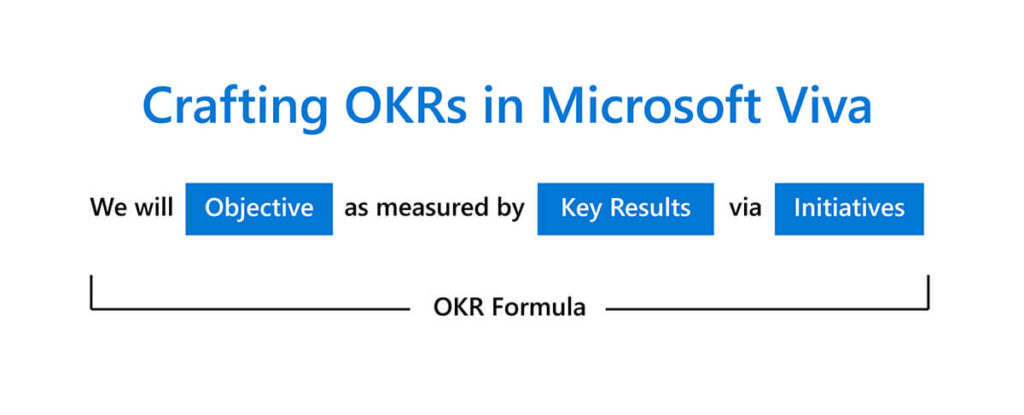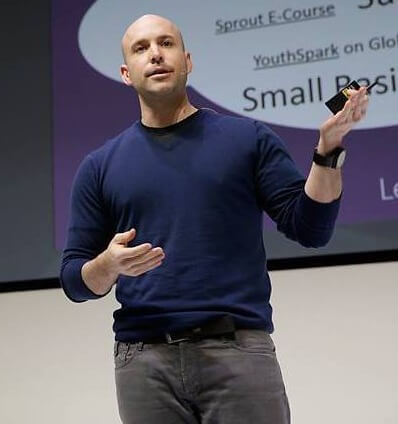 Employers everywhere are changing the way they think about work. As the hybrid workplace becomes the norm for many companies, employees are embracing flexible work, seeking work-life balance, and increasingly pursuing purpose and fulfillment in their work. At the same time, employers want to make sure their employees are focusing in the most impactful areas, especially in this “do more with less” era.
Employers everywhere are changing the way they think about work. As the hybrid workplace becomes the norm for many companies, employees are embracing flexible work, seeking work-life balance, and increasingly pursuing purpose and fulfillment in their work. At the same time, employers want to make sure their employees are focusing in the most impactful areas, especially in this “do more with less” era.
Fundamentally, employees and teams need to connect their jobs to the top organizational goals, be clear on their contribution, and align cross-functionally. Setting and shaping clear goals is essential for teams and individuals to understand their priorities and impact. According to the 2022 Microsoft Work Trend Index Special Report, employees who report having clarity about their work priorities are almost 4 times as likely to stay at the company for more than two years. They’re also more than 7 times as likely to think less about looking for a new job and 4.5 times as likely to say they’re happy at their current company. However, the same research shows that only 13 percent of frontline managers clearly understood how their work contributed to the larger company strategy, and 72 percent of executives couldn’t name their company’s top three goals.
This gap between the pursuit of meaningful and clear sense of purpose and actual employee experiences needs to be repaired as the work environment becomes more complex, uncertain, rapidly changing, and demanding more with less. Employees need to feel energized and empowered to do meaningful work, which requires direct and clear connection with company goals and strategy, cross-functional alignment with peers and teams, and ability to deliver in an increasingly uncertain economic landscape.
[See how we’re evolving our culture with Microsoft Viva internally at Microsoft. Learn more about how we’re using OKRs and Microsoft Viva Goals internally at Microsoft. Check out the lessons we’ve learned from our adoption of Microsoft Viva internally at Microsoft. Learn how we’re fostering a culture of learning at Microsoft with Viva Learning. Discover how we’re improving our own Employee Experience—and yours—as Microsoft’s Customer Zero.]
Aligning work and creating clarity with objectives and key results
At Microsoft, we’re using objectives and key results (OKRs) and Microsoft Viva Goals to align team priorities with business goals, helping to create a sense of purpose for our employees, clarify their impact, and connect priorities and achievements in all areas of our business.
OKRs align our entire organization to a common set of strategies, shifting focus to meaningful business outcomes and away from disconnected work priorities and outputs. OKRs enable our employees to focus on the projects and tasks that align to the objectives and key results that matter most to Microsoft and their teams, aligning their everyday work to the big picture of our business. This practice increases employee engagement, sharpens employees’ focus, and creates a shared understanding of how everyone is moving the company forward.
Microsoft Viva Goals provides a platform within which any organization’s employees and managers can use the OKR framework to set and execute goals while establishing clarity, purpose, and alignment. The OKR framework is supported by several components:
- Objectives are clear, inspiring, ambitious goals that define what teams or business groups want to accomplish. There are key questions to ask when establishing objectives: What is the most important area of our business to focus on? Why does that matter for us? How could we write that into a statement that inspires our team? Here’s an example of a good objective: “Deliver a ‘must-have’ product to delight customers and grow our user base.”
- Key results are the team or business group’s measurable outcomes. When establishing key results, ask the following questions. How will we know if we’re successful at achieving our objective? How can we measure the impact of our work? What is our best-case scenario for achieving that measure? Here’s an example of a relevant key result: “Increase our customer satisfaction score from 40 to 50.”
- Initiatives are activities that help the team achieve their key results. This is the work that teams do to execute on their OKRs. The following questions are helpful in determining the initiatives for an OKR: What do we need to do to be successful? What can we get done in this period? Who needs to be involved? Here’s a project that would contribute to the above key result: “Build a dashboard to track user experience in the new app.”
The OKR formula works like this:

Microsoft Viva Goals and the OKR framework is intended to get an entire organization, team, or groupings of employees focused and aligned on strategic priorities. OKRs support and integrate with project and task management solutions, they don’t replace them. OKRs measure business success, they’re not a measure of individual performance or a way to manage business-as-usual tasks. With Viva Goals, teams track aspirational goals that drive the business forward, not the day-to-day work of our employees.

OKRs help connect employees to the mission of an organization. Microsoft Viva Goals makes the OKR framework work in scalable and user-friendly ways. It accelerates the adoption of best practices for building and managing OKRs in one place with guidance and structure to support adoption. Viva Goals enables managers and employees to interact with their goals in the flow of work, surfacing and supporting the OKR framework in the tools they use everyday and enabling focus on what matters.
- Effective decision making: Microsoft Viva Goals provides our employees with a single source of truth so they can make swift, informed decisions. Importantly, they don’t need to manually track their progress when they get work done—Viva Goals automatically makes updates for them as they go.
- Be in the flow: Bringing our employees’ business goals and purpose into the flow of their work is simplifying adoption of our OKRs at scale without disrupting individual work.
Using Microsoft Viva Goals at Microsoft as Customer Zero
Microsoft is the first and best customer of its own products. We are “Customer Zero.” As a large enterprise customer and employer, many of the issues Microsoft faces when deploying its own products are not unique. They are shared by other large multinational enterprises, and even by small-and-midsized customers.
As Customer Zero for Microsoft Viva Goals, we have a unique opportunity to inform product development by aligning closely with product teams and internal stakeholders responsible for deployments, granting us the ability to address challenges other customers may experience through early and extensive feedback.
We want challenging but attainable goals at Microsoft—we don’t expect 100 percent of our objectives to be met. If that’s the case, our goals aren’t ambitious enough.
—Scott Blackwell, principal program manager, Microsoft Viva Goals
We collaborate closely with the Microsoft Viva product development team to share employee feedback that improves the experience. As part of our Customer Zero partnership, Microsoft leaders and our implementation teams get early access to new features and a chance to steer the product roadmap in a direction that best meets real enterprise needs. Additionally, it sharpens our focus on skills and learning in the spirit of growth mindset and enables our own experts at Microsoft to provide industry-relevant context and feedback into the Viva Goals development process.
Our Customer Zero journey with Microsoft Viva Goals began before Viva Goals was a product. We’ve been using the OKR framework at Microsoft for two to three years and learned a lot along the way.
Scott Blackwell is Principal Program Manager for Viva Goals at Microsoft. He emphasizes the importance of practice in enabling successful implementation of OKRs and Viva Goals at Microsoft.
“Ultimately, using OKRs at Microsoft isn’t primarily about tooling. It’s more about the practice of goal-setting and what it means to implement OKRs into the mindset of our business,” Blackwell says. “It’s about how we set and drive those objectives and key results through leadership and communication. We want challenging but attainable goals at Microsoft—we don’t expect 100 percent of our objectives to be met. If that’s the case, our goals aren’t ambitious enough.”
To implement OKRs successfully, employee experience and culture need to be at the center. OKRs help accelerate culture change, in a simple and systematic way, employee by employee, organization by organization.
— Don Campbell, senior director, OKR Enterprise Accelerator team, Microsoft Viva Goals
Using OKRs and Microsoft Viva Goals to remove roadblocks and help employees work more efficiently is what is driving the company’s success. The internal development of Viva Goals has also helped us improve our employee experience and has increased our employees’ engagement with Microsoft Viva. Our deep experience with OKRs as an organization has provided the Viva Goals development team with a customer that can provide feedback, inform the development process, and help to create a product that supports the OKR framework with an engaging experience for both employees and leadership.

Driving adoption with employee focus and key roles
Our adoption of Microsoft Viva Goals at Microsoft is driven by our culture. Having our executives and leadership teams sponsor and promote OKRs within their business groups was as important—if not more important—than technically implementing the toolset. OKRs are, at their core, outcomes and productivity drivers that impact every employee, aligning each of them to the purpose of the organization.
Don Campbell is the Senior Director of the Microsoft Viva Goals OKR Enterprise Accelerator (OEA) team. “To implement OKRs successfully, employee experience and culture need to be at the center,” Campbell says. “OKRs help accelerate culture change, in a simple and systematic way, employee by employee, organization by organization.”
It’s about helping your employees stay focused on your strategy and vision.
“OKRs underpin the direction and purpose of the organization,” he adds. “It’s not just what you do, but why you do it, and how. If someone comes to me with an idea for some line of work or project, I’m immediately going to ask how it’s aligned to the key results we have in place. I’ll ask questions about the outcome, the timing, whether it’s the right thing. These lead to conversations that enhance clarity and ensure alignment across anything we do.”
Establishing team roles and identifying the people and teams that can accelerate adoption is at the focus of our internal plans for OKRs and Microsoft Viva Goals. A shift to greater clarity and better alignment must happen across the organization. We’ve identified several important roles in the adoption process that any company should incorporate into their plans for Viva Goals and OKRs:
- The executive sponsor has a clear vision for OKRs and the benefits of the framework. They work to communicate with leadership and ensure that company leaders have the guidance and encouragement to enable OKRs for their teams and embed a goal-setting culture across the organization.
- OKR champions facilitate the OKR process. They are the OKR experts, acting as a resource for OKR information, answering questions about OKR adoption, and encouraging adoption.
- Team managers are at the forefront of helping employees to achieve their business outcomes in the context of objectives and key results. Team managers have a deep understanding of their team’s OKR and maintain OKR focus across the projects that team members are working on.
- Human resources (HR) leaders support company-wide adoption and alignment to accelerate company culture and employee experience. They also supply access to learning and development planning resources, consistent adoption messaging, and they support team leaders in the practical implementation of the OKR framework.
- Admin and IT teams implement the technology necessary to put Microsoft Viva Goals and the OKR framework in front of every employee in the organization. Meeting employees in the flow of work and creating an engaging employee experience.
Implementing OKRs with Microsoft Viva Goals
Rajesh Jha is Executive Vice President of Experiences and Devices at Microsoft. His team is responsible for building many Microsoft products, including Windows, Microsoft 365, Edge, and Bing. The Experiences + Devices team recently adopted Microsoft Viva Goals for OKRs management as an organization, with Jha’s executive sponsorship leading the way.
The 40,000 global employees on the Experiences and Devices team journeyed through a 12-week adoption of Microsoft Viva Goals, coming from a variety of OKR maturity levels and solutions. Like much of Microsoft, OKRs were not new to Jha and his team, but having Viva Goals available as a universal tool to manage OKRs across the entire organization was.
The OKR Enterprise Accelerator (OEA) team at Microsoft led and managed the Experiences + Devices implementation. They identified the key roles to be filled to support Microsoft Viva Goals rollout, including Jha as the executive sponsor. Internal communications and leadership teams from Experiences and Devices provided leadership and communications to employees, while Microsoft HR and Microsoft Digital provided HR and IT support. The enterprise accelerator team provided the initial OKR champions, but also developed local OKR champions within the Enterprise and Devices organization.
The OEA team established a workback schedule and implementation timeline according to the maturity levels and implementation needs of the teams across the department. The extended Experiences + Devices leadership team signed off on the project and messaging plan and the OEA team began a 4-week sprint with OKR champions to get all OKRs established and set in Microsoft Viva Goals across leadership and team managers.
After the initial sprint, leadership and team managers engaged with their employees—more than 40,000 of them—to adopt Microsoft Viva Goals for OKR management. This meant establishing ongoing rhythms, ensuring that Viva Goals in Microsoft Teams was available to and used by employees. From there, they aligned key results and projects with their employees and teams. Some of the most important activities in our rollout to Experiences and Devices team included:
- Defining the criteria for success. We had to establish OKRs to guide our OKR rollout! These OKRs helped define what success meant and focused us on what we wanted to accomplish.
- Establishing program guidance documentation. We drafted a set of resources that provided Q and A style information to answer typical questions and provide a common base for understanding. This documentation was available to all employees.
- Holding weekly community meetings. These meetings informally brought our OKR champions together and helped build connections and best practices that were shared across the team.
As Customer Zero for Microsoft Viva Goals, we’ve learned and grown along our journey with OKRs at Microsoft. In our environment, we’re currently using Viva Goals to manage almost 9,000 objectives, more than 21,000 key results, and approximately 4,000 projects.
Our relationship with the Viva Goals product team as Customer Zero has resulted in more than 160 design and feature change suggestions, removal of more than 140 bugs, and almost 2,000 teams at Microsoft using Viva Goals.
What’s Next
Our journey with Microsoft Viva Goals is ongoing. We’re working towards large-scale adoption of Microsoft Viva Goals in the current fiscal year and, subsequently, broader adoption of the OKR practice at Microsoft. We strongly believe it will increase employee engagement, clarity of goals and impact, sense of meaningful work, and feeling a part of achieving our collective purpose.
The success of our implementation with Experiences and Devices and many other large Microsoft organizations is the beginning of building a broader awareness of the OKR framework and Microsoft Viva Goals at Microsoft. Our OEA team continues to guide Viva Goals adoption throughout the wider Microsoft organization.
We’ve established several must haves for a successful Microsoft Viva Goals rollout.
- You should Identify a committed executive sponsor. Make sure you have enthusiastic leaders accountable for the success of the overall program—not just within individual teams.
- Build a public timeline linked with key planning milestones. Hold your team accountable and create a valuable sense of urgency.
- Build a network of local OKR champions to evangelize the change and provide avenues for average employees to get reactive support while maintaining strong ownership by team leaders.
- Communicate clear expectations and create community. Ensure expectations and asks are clear and concise at all points throughout the process.
The OKR framework and Microsoft Viva Goals is providing real business benefit at Microsoft and to Microsoft customers. Some of our most significant benefits from using Viva Goals include:
- Better alignment. Knowledge sharing and cross-functional visibility highlight collaboration opportunities so teams can identify joint priorities and pull resources together.
- Greater focus. Leaders have a heightened sense of clarity and accountability, and they can relay this to employees at company wide meetings to reinforce focus areas.
- More transparency. Microsoft Viva Goals provides a single source of truth for goals and how daily work contributes. Leaders understand how they are tracking towards goals without having to track down data. Employees understand how the projects they are working on impact team and company goals.
- Increased agility. Healthy business rhythms emerge around goals. Weekly meeting around progress towards OKRs aligns teams on the types of opportunities to target and helps continually refocus team actions on what’s most important, even when what’s most important changes.
- Elevated achievement. The entire organization builds a portfolio of accomplishment and a culture of celebration. The company no longer talks about activities and tasks, but instead celebrates impact within existing celebratory patterns.
- See how we’re evolving our culture with Microsoft Viva internally at Microsoft.
- Learn more about how we’re using OKRs and Microsoft Viva Goals internally at Microsoft.
- Check out the lessons we’ve learned from our adoption of Microsoft Viva internally at Microsoft.
- Learn how we’re fostering a culture of learning at Microsoft with Viva Learning.
- Discover how we’re improving our own Employee Experience—and yours—as Microsoft’s Customer Zero.

Want more information? Email us and include a link to this story and we’ll get back to you.








